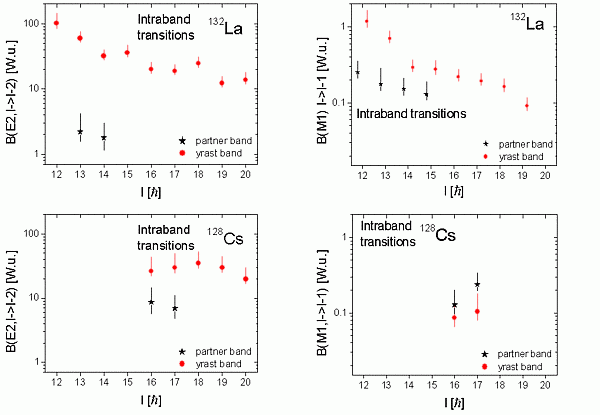Pasma chiralne
Wersja polska w przygotowaniu…
Strona popularnonaukowa o pomiarach czasów życia metodami dopplerowskimi
In Beam Chirality Study with the Warsaw Cyclotron
Nuclear Physics Division, Warsaw University
Ch. Droste, E. Grodner, M. Kowalczyk, J.Mierzejewski, T. Morek, J. Srebrny, M. Sałata, P. Tarnowski, I. Zalewska
A. F. Ioffe Physical-Technical Institute St.-Petersburg
A. Pasternak
Heavy Ion Laboratory, Warsaw University
J. Kownacki, A. Kordyasz, P. Napiorkowski, M. Wolińska-Cichocka
The A. Sołtan Institute for Nuclear Studies, Świerk
M. Kisieliński, R. Kaczarowski, W. Płóciennik, E. Ruchowska, A. Wasilewski
Łódź University
J. Perkowski
Department of Physics and Astronomy, SUNY at Stony Brooks
D. B. Fossan, T. Koike, K. Starosta
Thanks are due to :
- IKF Julich (R. Lieder) for OSIRIS frame, BGO ball , electronics and 6 ACS Ge spectrometers ( + 3 Ge)
- Nuclear Physics Institute – Kraków (W. Męczyński) for 2 ACS Ge spectrometers
- NORDBALL collaboration and Jyvaskyla for 2 ACS and 4 Ge detectors
Recent theoretical and experimental works have attracted attention to the problem of chirality in atomic nuclei with odd numbers of protons and neutrons. In these nuclei the total nuclear spin is built from the valence proton and valence neutron momenta and angular momentum of the even-even core. These three vectors can be mutually perpendicular and coupled in two manners forming systems (left- and right-handed) with opposite chirality in the intrinsic frame of the nucleus. In the laboratory frame it manifests itself as the presence of two rotational bands, nearby degenerated, with the same parities. The study of the chiral twin bands is in its very early stage. For example, there is a lack of data on the lifetimes of states belonging to the chiral bands. Such data carry important information on nuclear wave functions.
We plan to study lifetimes in the 130La and 132La nuclei in which candidates for chiral bands have been found.
The 132La and 128Cs nuclei were produced in in the following reactions:
- 122Sn(14N,4n)132La E(14N) = 75 MeV
- 122Sn(10B,4n)128Cs E(10B) = 55 MeV
The Warsaw Cyclotron and the OSIRIS II multidetector spectrometer were used. For general information on the OSIRIS-II spectrometer please refer to the OSIRIS page.
History of Chirality in Nuclear Physics
|
1997 19962001-20032002 2003 2004 |
Preliminary results on 128Cs – June 2004 run
First results show that in 128Cs differences in B(E2) values between the “yrast” band (band 1) and supposed partner chiral band (band 2 ) are much smaller than in the case of 132La (see figures below)


